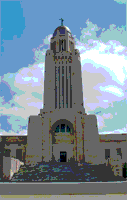Center, Public Policy, University of Nebraska

University of Nebraska Public Policy Center: Publications
Date of this Version
2009
Abstract
Immigration reform has been a part of the United States policy discussions since the 18th century. As early as 1790, Congress was developing laws to allow immigrants to become United States citizens. By 1891, due to the amount of immigrants flowing into the country, the federal government assumed responsibility for immigration control and the Immigration Service was established. Over the past century, policies regulating immigration have transformed reflecting public concern over changing migrant flows into the country. During World War I, immigration levels were relatively low, but when the mass flow resumed post World War I, Congress enacted the Quota Law which set quantitative restrictions based on nationality representation in the United States census. The American public adopted a more liberal attitude towards foreign immigration following World War II, which lasted relatively up until the late 1970s when the presence of significant numbers of undocumented immigrants raised public concern.
Currently, it is estimated that there are approximately 12 million unauthorized
immigrants living in the United States, with about 55% of that number originating from Mexico. Undocumented immigrants represent more than half of those coming into the nation annually (see Table 1). According to the United States Census Bureau 2006 America Community Survey Fact Sheet, there were an estimated 99,500 foreign born immigrants in Nebraska, constituting 5.6% of the population. (This likely has increased markedly in the past decade.) The majority of the foreign-born population is of Hispanic/Latino descent, and the Latino population increased 155% in Nebraska from 1990 to 2000. The Pew Hispanic Center estimated that in 2005, there were anywhere from 35,000 to 55,000 undocumented immigrants in Nebraska.


Comments
Published by the University of Nebraska Public Policy Center, (2009), 1-21